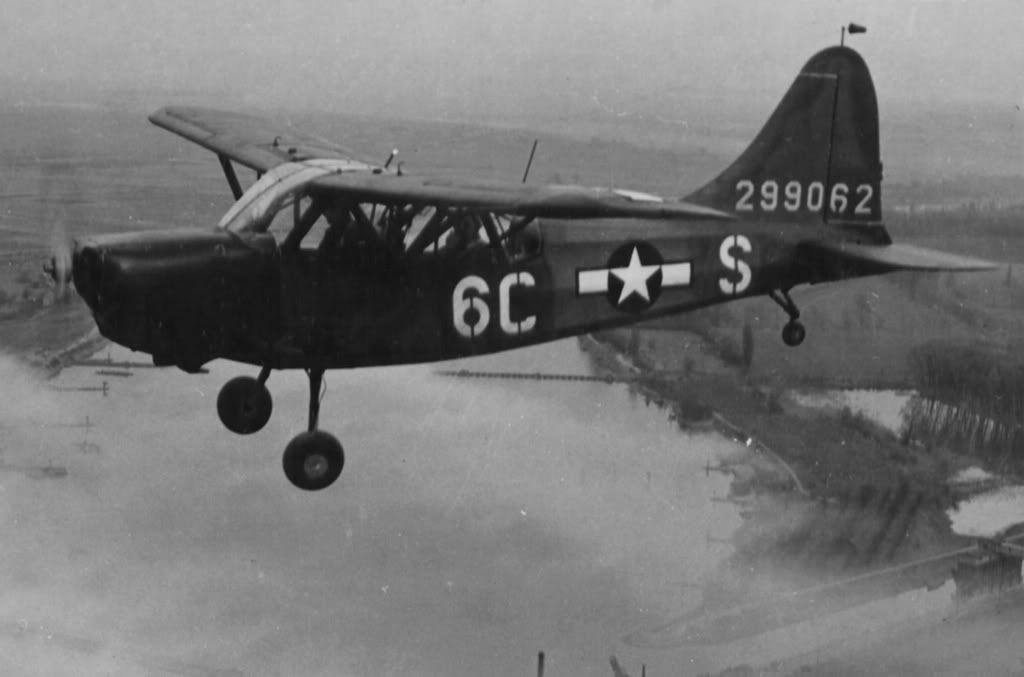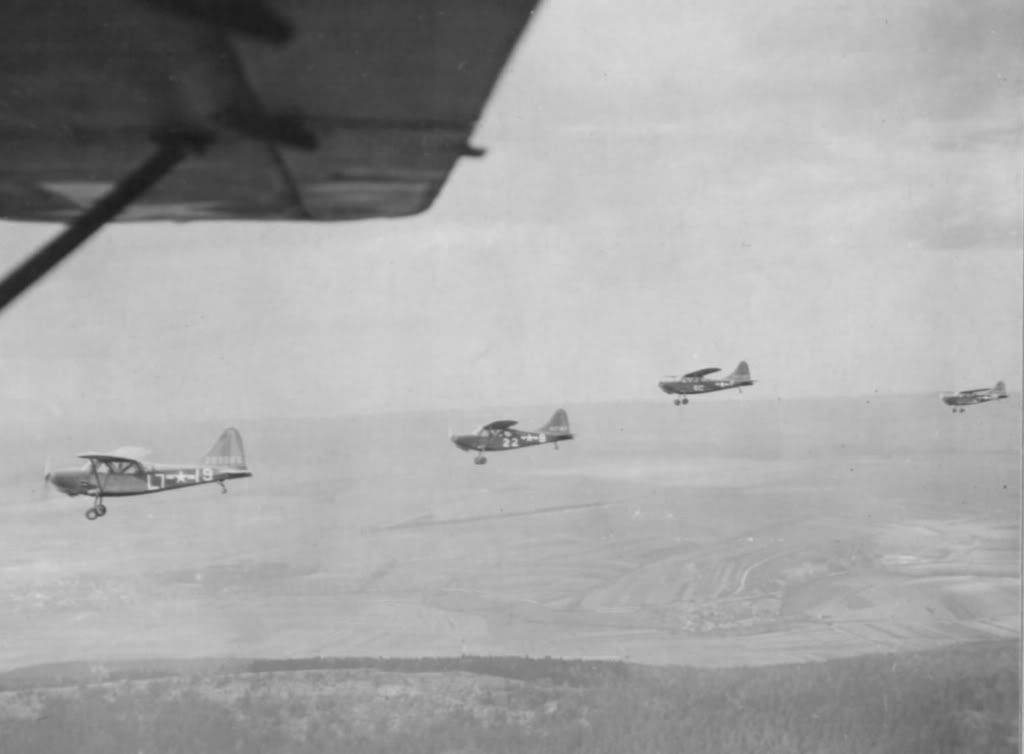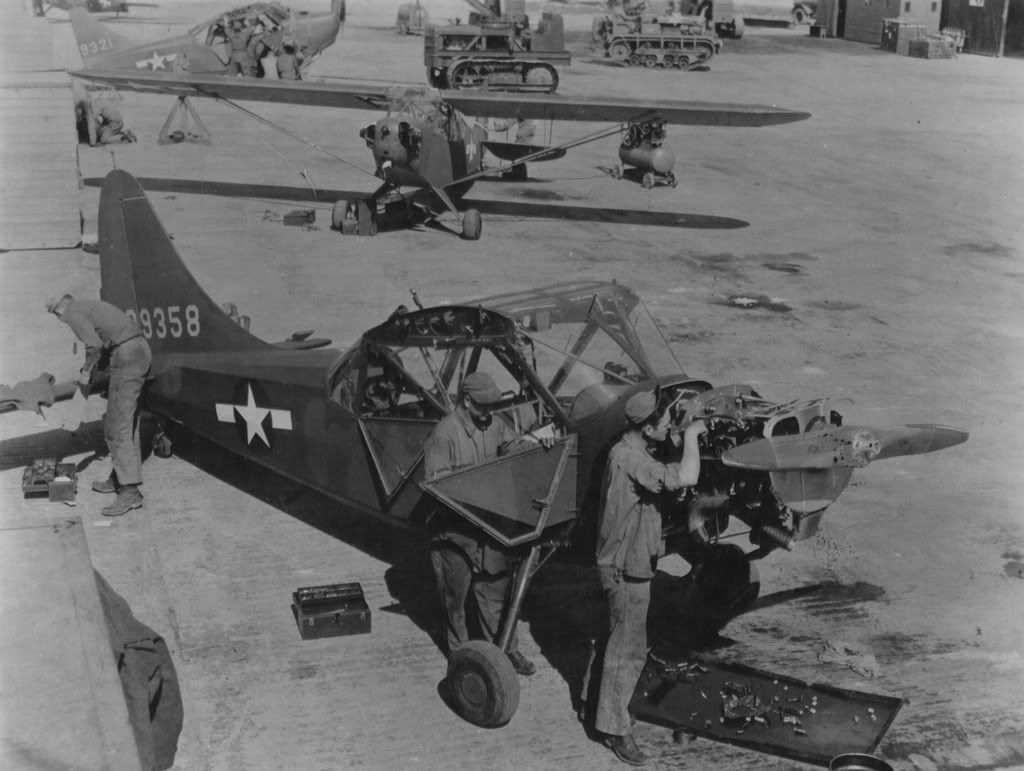Special Photos for My L-5 Friends
Mon Mar 03, 2008 10:52 pm
To post or not to post 




L-5 s/n 42-99062 Germany 1945

L-5s over Germany 1945

L-5 and L-4s being assembled in France 1944

L-5 s/n 42-99062 Germany 1945

L-5s over Germany 1945

L-5 and L-4s being assembled in France 1944
Great!
Mon Mar 03, 2008 11:29 pm
Jack,
Thanks much! I'll let Jim know they are there.
Thanks much! I'll let Jim know they are there.
Mon Mar 03, 2008 11:47 pm
Keep 'em coming Jack!
Tue Mar 04, 2008 8:51 am
Thanks! Those are nice shots! Any more information about that gaggle of L-5s in the second shot? Their codes don't seem to match up at all.
Ryan
Ryan
Tue Mar 04, 2008 11:39 am
Ryan,
In the back of my feeble and small mind it seems that the codes on some liason birds were assigned by the ground units to which they were attached. There was also quite a bit of leeway on how the codes were applied apparently. I can't remember where I saw this, but it was in some reference book pertaining to AAF markings.
Scott
In the back of my feeble and small mind it seems that the codes on some liason birds were assigned by the ground units to which they were attached. There was also quite a bit of leeway on how the codes were applied apparently. I can't remember where I saw this, but it was in some reference book pertaining to AAF markings.
Scott
Fri Mar 07, 2008 3:07 pm
Minor correction to one of the photo captions. The aircraft are almost without a doubt being assembled in England, not France. 42-99358 arrived in the UK on June 8, 1944, coincident with the arrival of the 125th Liaison squadron, whose aircraft were flown to France from England on September 1st, 1944. The maintenance depots responsible for assembling aircraft did not move over to the continent until much later.
Fri Mar 07, 2008 3:45 pm
Aircraft markings were assigned by convention though not always applied correctly by the units that operated them, but for two of the aircraft in the formation photo they are as follows:
22*B = 2nd Corps field artillery
6C*F = 14th Liaison Squadron
L7*22 is known to have belonged to the 406th Bomb squadron, so L7*19 in this photo most likely belonged to that or one of the half-dozen other "carpetbagger" squadrons involved in special operations.
Since none of these aircraft would have normally operated together, and group flights of liaison aircraft were rare, an educated guess says these planes were being delivered to a storage depot late in 1945 after the war was over.
22*B = 2nd Corps field artillery
6C*F = 14th Liaison Squadron
L7*22 is known to have belonged to the 406th Bomb squadron, so L7*19 in this photo most likely belonged to that or one of the half-dozen other "carpetbagger" squadrons involved in special operations.
Since none of these aircraft would have normally operated together, and group flights of liaison aircraft were rare, an educated guess says these planes were being delivered to a storage depot late in 1945 after the war was over.
Fri Mar 07, 2008 4:05 pm
Neat Photo's! 
What's the wind-stock looking thing on the vertical stablizer in the first photo supposed to be or doing?
Thanks for sharing.
What's the wind-stock looking thing on the vertical stablizer in the first photo supposed to be or doing?
Thanks for sharing.
Fri Mar 07, 2008 4:40 pm
GIJOE290 wrote:What's the wind-stock looking thing on the vertical stablizer in the first photo supposed to be or doing?
Trailing wire antenna. You pay it out in flight and the drogue keeps it some what under control.
Fri Mar 07, 2008 4:45 pm
Cool stuff man.
Fri Mar 07, 2008 4:46 pm
The little wind sock is a part of the trailing wire antenna. There was a spool of antenna wire with a hand crank and a friction brake. The antenna would be let out a specific length depending on the frequency they were using on the radios. A pre determined antenna length for a specific frequency was used to get the most range out of the transmitter and receiver.
Larger aircraft like the bombers, C-46, C-47, ,and pretty much everything that carried a radio operator had a trailing wire antenna but they were usually electrically operated and had a 7 pound teardrop weight that was attached to the end of the antenna wire to pull it out.
Smaller aircraft like this L-5 used a little wire frame, rubber coated wind sock to pull the antenna out when the friction brake was loosened up. There was an insulator mounted in a clamp on the top of the L-5 rudder right on the hinge line. The antenna wire ran through the insulator and attached to the little sock.
Does anyone know how they kept track of the length of wire spooled out? The larger aircraft had a counter in the control head that was geared to the spool/motor assembly.
Sure love your photos and information Jack! Please keep ‘em here on the front page.
Taigh
Larger aircraft like the bombers, C-46, C-47, ,and pretty much everything that carried a radio operator had a trailing wire antenna but they were usually electrically operated and had a 7 pound teardrop weight that was attached to the end of the antenna wire to pull it out.
Smaller aircraft like this L-5 used a little wire frame, rubber coated wind sock to pull the antenna out when the friction brake was loosened up. There was an insulator mounted in a clamp on the top of the L-5 rudder right on the hinge line. The antenna wire ran through the insulator and attached to the little sock.
Does anyone know how they kept track of the length of wire spooled out? The larger aircraft had a counter in the control head that was geared to the spool/motor assembly.
Sure love your photos and information Jack! Please keep ‘em here on the front page.
Taigh
Fri Mar 07, 2008 5:19 pm
Wow that's right interesting stuff!! Thanks Wheels up & Taigh for explaining that. 
Cranks
Fri Mar 07, 2008 10:35 pm
Does anyone know how they kept track of the length of wire spooled out?
You count your cranks as you send them out. There is a specific number needed (it's a quarter wave antenna). Then there is a cat's eye in the radio that tells you you are tuned to the right range for the frequency. You can adjust the length of the wire for optimal tuning after that. Two of the pilots I have spoken to absolutely hated using the radios.